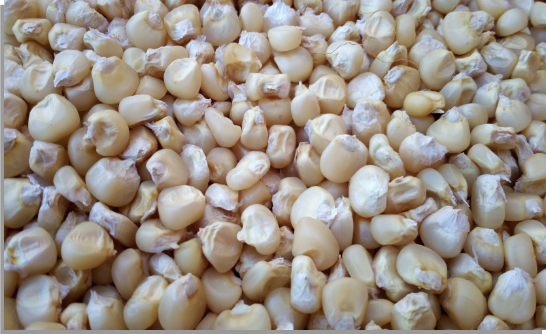Crop: Zea mays L. spp. mays (Maize)
This landrace is a traditional white corn, flint, it can reach a height of 1.80m and an estimated production of 3 to 4 tones /ha.
The traditional variety of Arcos white corn is used to make the traditional corn bread–broa de milho. To prepare the ‘broa de milho’, four parts of corn and one of rye must be stone milled, sifted, and heaped into the wooden ‘masseira’ (kneading trough).
Maize is grown under strong organic conditions with manure, sown by hand between mid-April and mid-May and without chemical weeding. Irrigation is supported by collective irrigation water. Manual maize harvesting takes place between September and October. The plants are harvested and defoliated after a few days. The ears are selected and stored in traditional granaries, in Portuguese ‘espigueiros’, a structure suitable for the conservation of the ears of maize, during the winter. The straw is tied and put into ‘medas’ and then fed to the farm animals. The threshing of the ears is done as needed and is manual. Traditionally the grain is stored in wooden boxes.
Cultivation System: ND.
Geographical Information
Country: Portugal
Arcos de Valdevez – Parishes Rio Frio, Sistelo, Soajo e Cabreiro
Farmer(s) description:
ND.
Propagation system: Seed, cross-pollination
Multiplication procedures and consequences on landrace diversity:Local farmers select the best ears to sow in the following year. The maize ears result from open pollination. It is cultivated in a mountainous area with strong geographical isolation, the landrace is homogeneous, cultivated according to ancient precepts and people continue to make their bread and use the grain in soups.
Management plan existence:The landrace management relies completely on farming activities within the area. Currently, no technical or scientific support is provided to farmers.
Added Values
This landrace has potential for new uses.
Others (e.g. commercial/geographical brands or special traits):‘The bread–Broa dos Arcos–is included in the Slow Food Catalogue; the local and dynamic tourism activities, a fast-growing segment, allows a sustainable market.
Due to the high quality of the maize flour, local associations and other public and private agents, have an increased perception of the value of this landrace which, together with a renewed interest in agriculture in Portugal, gives hope for its on-farm conservation in the near future.
To have access to the resource please contact:
BPGV, INIAV I.P.
For more information on this regional variety:
https://www.fondazioneslowfood.com/en/ark-of-taste-slow-food/broa-de-milho-2/
Case study provided by Instituto Nacional de Investigação Agrária e Veterinária (INIAV), Portugal.
- Paulo Moreiras. 2014. Pão & Vinho mil e uma histórias de comer e beber. Publicações D. Quixote. Leya
- Alda Brás. 2003. O itinerário técnico da consociação milhoxfeijão na Serra da Peneda. In ‘Cadernos da Montanha Peneda-Soajo II’, pp 9-23.
